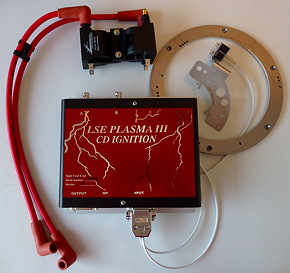 |
PLASMA
CDI FEATURES
CAPACITIVE DISCHARGE IGNITION SYSTEM |
Light Speed Engineering's
Plasma CDI Features
Light
Speed Engineering, LLC is well known for its world record
setting flight efficiency and consistent racing
victories. The Plasma CDI plays a significant part
in the success of many racers and sport pilots who
put reliability and performance on top of their
list.
Proven to be the
best the industry has to offer, the following list
notes several unique features of the LSE Plasma CDI
systems that are not available in any other aircraft
ignition:
| |
Easy
installation with built in timing light on
the accessory case sensor module or a prefabricated
adjustable crank sensor assembly on direct
crank sensor systems. |
| |
Hot
Spark: >130 mJ spark energy @ 0 - 3500
RPM |
| |
Best
firing accuracy, cycle to cycle and cylinder
to cylinder |
| |
Largest
input voltage range: 5V - 35V |
| |
Minimum
current consumption: 4-cyl: 0.5A, idle -
1.2A, cruise
6-cyl: 0.5A, idle - 1.9A, cruise |
| |
Light
weight: CDI Ignition module: Plasma III- 1.7
lbs, Plasma II & II Plus- 1.1 lbs
Dual Output Mini Ignition coils: 5 oz. each |
| |
Low
"noise" makes it Storm Scope
compatible |
| |
Best
shunt resistance (fires wet and fouled
plugs) |
| |
Aircraft
Key Switch Starting available on Plasma III
and Plasma II Plus |
| |
Solid-State,
Discrete
logic (no microprocessor) for maximum
reliability: No Software & No Software
Updates |
| |
Interconnect
feature:
On dual LSE Plasma III or II Plus CDI
installations, the control module
automatically shifts the timing curve as
needed when only one system is operating. |
| |
Hand
Starting (Armstrong Starter):
Unlike other electronic ignition systems,
aircraft equipped with the LSE Plasma CDI
may be hand-propped. |
CDI Features
Electronic
ignition (EI) has been used on automobiles for over
forty-five years, yet the aircraft industry has been
unresponsive in adopting any form of EI technology,
and letting go of the nearly 100 year old magneto.
Electronic
ignition offers four distinct advantages over a magneto based
ignition system:
The first is
reliability. Electronic systems have
no moving parts and can be expected to operate much longer,
requiring less attention and maintenance than mechanical systems.
Second,
capacitor discharge ignition systems produce a much larger and
hotter spark compared to a magneto - up to 40,000 volts versus a
maximum of 17,000 volts from the magneto. The more powerful spark
allows a larger gap, which improves hot and cold starts as well as
power and fuel efficiency.
Third,
and possibly the biggest asset to electronic ignition systems, is
that the electronics permit automatic spark timing optimized to RPM,
manifold pressure and altitude conditions. The combination of these
features maximizes fuel economy and power, ultimately allowing the
Plasma CDI ignition system to pay for itself through lower operating
costs.
Finally,
the components for electronic systems are all mass produced, giving
electronic ignition a distinct cost advantage over replacement parts
for magnetos.
|